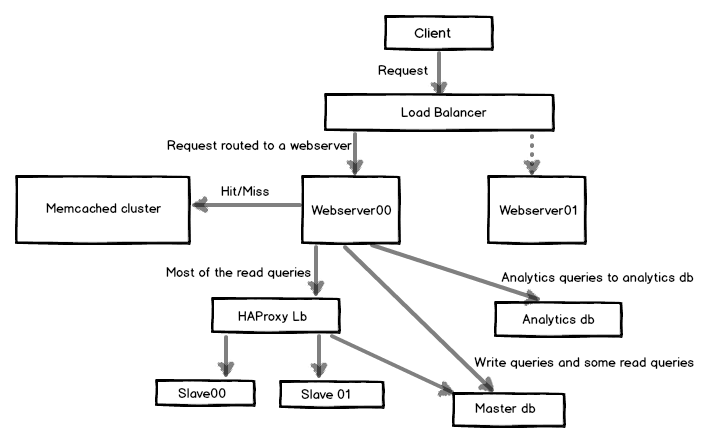MySQL – Primary data store
At HackerEarth, we use MySQL database as the primary data store. We have experimented with a few NoSQL databases on the way, but the results have been largely unsatisfactory. The distributed databases like MongoDB or CouchDB aren't very scalable or stable. Right now, our status monitoring services use RethinkDB for storing the data in JSON format. That's all about using NoSQL database for now.With the growing amount of data and number of requests every second, it turns out that the database becomes a major bottleneck to scale the application dynamically. At this point if you are thinking that there are mythical (cloud) providers who can handle the growing need of your application, you couldn't be more wrong. To make matters worse, you can't spin a new database whenever you want to just like you do with your frontend servers. Achieving horizontal scalability at all levels requires massive re-architecture of the system while being completely transparent to the end user. This is what a part of our team has focused on in the last few months, resulting in high uptime and availability.
It was becoming difficult for the master (and only) MySQL database to handle the heavy load. We thought we will delay any scalability at this level till the single database could handle the load. We would work on other high priority tasks instead. But that wasn't to be, and we experienced some down time. After that we did a rearchitecture of our application, sharded the database, wrote database routers and wrappers on top of django ORM, put HAProxy load balancer infront of the MySQL databases, and refactored our codebase to optimize it significantly.
The image below shows a part of the architecture we have at HackerEarth. Many other components have been omitted for simplicity.

Database slaves and router
The idea was to create read replicas and route the write queries to the master database and read queries to slave (read replica) databases. But that was not simple either. We couldn't and wouldn't want to route all the read queries to slaves. There were some read queries which couldn't afford stale data, which comes as a part of database replication. Though stale data might be the order of just a few seconds, these small number of read queries couldn't even afford that. The first database router was simple:class MasterSlaveRouter(object):
"""
Represents the router for database lookup.
"""
def __init__(self):
if settings.LOCAL:
self._SLAVES = []
else:
self._SLAVES = SLAVES
def db_for_read(self, model, **hints):
"""
Reads go to default for now.
"""
return 'default'
def db_for_write(self, model, **hints):
"""
Writes always go to default.
"""
return 'default'
def allow_relation(self, obj1, obj2, **hints):
"""
Relations between objects are allowed if both objects are
in the default/slave pool.
"""
db_list = ('default',)
for slave in zip(self._SLAVES):
db_list += slave
if obj1._state.db in db_list and obj2._state.db in db_list:
return True
return None
def allow_migrate(self, db, model):
return True
# proxy_slave_X is the HAProxy endpoint, which does load balancing
# over all the databases.
SLAVES = ['proxy_slave_1', 'proxy_slave_2']
def get_slave():
"""
Returns a slave randomly from the list.
"""
if settings.LOCAL:
db_list = []
else:
db_list = SLAVES
return random.choice(db_list)
class BaseManager(models.Manager):
# Wrappers to read from slave databases.
def get_from_slave(self, *args, **kwargs):
self._db = get_slave()
return super(BaseManager, self).get_query_set().get(*args, **kwargs)
def filter_from_slave(self, *args, **kwargs):
self._db = get_slave()
return super(BaseManager, self).get_query_set().filter(
*args, **kwargs).exclude(Q(hidden=True) | Q(trashed=True))
HAProxy for load balancing
Now there could me many slaves at a time. One option was to update the database configuration in settings whenever we added/removed a slave. But that was very cumbersome and inefficient. A better way was to put a HAProxy load balancer in front of all the databases and let it detect which one is up or down and route the read queries according to that. This would mean never editing the database configuration in our codebase — just what we wanted. A snippet of /etc/haproxy/haproxy.cfg:listen mysql *:3305
mode tcp
balance roundrobin
option mysql-check user haproxyuser
option log-health-checks
server db00 db00.xxxxx.yyyyyyyyyy:3306 check port 3306 inter 1000
server db01 db00.xxxxx.yyyyyyyyyy:3306 check port 3306 inter 1000
server db02 db00.xxxxx.yyyyyyyyyy:3306 check port 3306 inter 1000
DATABASES = {
'default': {
'ENGINE': 'django.db.backends.mysql',
'NAME': 'db_name',
'USER': 'username',
'PASSWORD': 'password',
'HOST': 'db00.xxxxx.yyyyyyyyyy',
'PORT': '3306',
},
'proxy_slave_1': {
'ENGINE': 'django.db.backends.mysql',
'NAME': 'db_name',
'USER': 'username',
'PASSWORD': 'password',
'HOST': '127.0.0.1',
'PORT': '3305',
},
'analytics': {
'ENGINE': 'django.db.backends.mysql',
'NAME': 'db_name',
'USER': 'username',
'PASSWORD': 'password',
'HOST': 'db-analytics.xxxxx.yyyyyyyyyy',
'PORT': '3306',
},
}
Database sharding
Next, we sharded the database. We created another database — analytics. It stores all the computed data, and it forms a major part of read queries. All the queries to the analytics database are routed using the following router:class AnalyticsRouter(object):
"""
Represents the router for analytics database lookup.
"""
def __init__(self):
if settings.LOCAL:
self._SLAVES = []
self._db = 'default'
else:
self._SLAVES = []
self._db = 'analytics'
def db_for_read(self, model, **hints):
"""
All reads go to analytics for now.
"""
if model._meta.app_label == 'analytics':
return self._db
else:
return None
def db_for_write(self, model, **hints):
"""
Writes always go to analytics.
"""
if model._meta.app_label == 'analytics':
return self._db
else:
return None
def allow_relation(self, obj1, obj2, **hints):
"""
Relations between objects are allowed if both objects are
in the default/slave pool.
"""
if obj1._meta.app_label == 'analytics' or \
obj2._meta.app_label == 'analytics':
return True
else:
return None
def allow_migrate(self, db, model):
if db == self._db:
return model._meta.app_label == 'analytics'
elif model._meta.app_label == 'analytics':
return False
else:
return None
DATABASE_ROUTERS = ['core.routers.AnalyticsRouter', 'core.routers.MasterSlaveRouter']
I would love to know how others have solved similar problems. Do give suggestions and point out potential quirks.
P.S. You might be interested in The HackerEarth Data Challenge that we are running.
Follow me @vivekprakash. Write to me at vivek@hackerearth.com.
This post was originally written for the HackerEarth Engineering blog by Vivek Prakash.


































